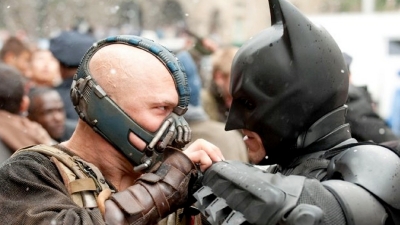Nolan's Batman Trilogy Ends While The Strife That Inspired It Goes On
By Steven Pate in Arts & Entertainment on Jul 23, 2012 6:25PM
 Director Christopher Nolan decided when rebooting the Batman franchise in 2003 to stake its success to an exploration of fear, moral ambiguity and the existential fragility of civilization, and to do so through a realism dependent on visceral resonance with current events. This Dark Knight would be dark indeed, a pitch-black tincture of terrorism, corruption, collapsing infrastructure, stock market fraud, chemical warfare, torture, rendition, financial collapse, illegal surveillance, and nuclear proliferation. Nolan's instincts were vindicated, and his talent rewarded, by extraordinary commercial success and critical accolades usually denied to comic book adaptations: the first two films collected $1.37 billion globally and won a posthumous supporting-actor Oscar for Heath Ledger.
Director Christopher Nolan decided when rebooting the Batman franchise in 2003 to stake its success to an exploration of fear, moral ambiguity and the existential fragility of civilization, and to do so through a realism dependent on visceral resonance with current events. This Dark Knight would be dark indeed, a pitch-black tincture of terrorism, corruption, collapsing infrastructure, stock market fraud, chemical warfare, torture, rendition, financial collapse, illegal surveillance, and nuclear proliferation. Nolan's instincts were vindicated, and his talent rewarded, by extraordinary commercial success and critical accolades usually denied to comic book adaptations: the first two films collected $1.37 billion globally and won a posthumous supporting-actor Oscar for Heath Ledger.
From its opening minutes, The Dark Knight Rises proceeds with the meaty finality of a concluding installment, and few fans of the earlier movies will be disappointed. Nolan executes his trademark multi-tiered climax, juggles a large ensemble with his usual deftness and provides enough thrills to justify the film's substantial length. Tom Hardy's Bane, a villain of terrifying physicality but uncharacteristically haphazard characterization, out-does even Christian Bale's distinctive Batman Voice (the grave yell-whisper of a man trying to save a civilization from itself) in a contest of outlandish but somehow fitting speaking styles. Anne Hathaway makes every scene she's in better. Good triumphs over evil, closure and continuity are doled out in satisfying proportion.
The filming location for the third installment was moved to Pittsburgh, and the film is shot through with the tentative hope of a rebuilding metropolis. The dark forces which threatened Gotham City in Batman Begins have returned to stamp out this stand-in for the civilization of the west through the application of fear and terror. This time, however, most of the battle is waged in daylight. Action sequences, such as the opening airplane operation and a punishing subterranean hand-to-hand fight between Bane and Batman, along with spectacular set pieces like the demolition of a football stadium, deliver on the promise of a $250 million budget.
The script struggles to convince us that “anyone could be Batman, that’s the point," that he is a symbol of our willingness to stand up, confront evil and hold chaos at bay. Never mind the hero's reliance on Bruce Wayne's $6.9 billion fortune and the surplus value of the corporate state (the defense department prototypes locked away by the Wayne corporation) for his arsenal. Batman himself mocks a poor schlub inspired by him to fight crime but unable to outfit himself in The Dark Knight, reminding the wannabe acolyte that the difference between them was that he was "not wearing hockey pads."
The Nolan Batman Saga ostensibly came to an end with Friday's opening, just as the turbulent strife it thematized roiled at a fever pitch. The Dark Knight Rises arrived at the height of this savage summer of brutal droughts, pitiless wildfires and scorched earth, this overheated season of epidemic violence, destabilizing revolutions and political armageddon. Then, of course, a deranged gunman opened fire on an audience at a premiere in Aurora, Colo., rendering bilateral the relationship between the film and the current events it mined for thematic material.
If our rush to wrap up the shooting with the movie betrays a residual guilt about this sort of bloody entertainment, it is worth making certain our queasiness about the theatricality of violence does not obscure the gulf between contemplating fictional violence and engaging in actual violence. If there had been no The Dark Knight Rises, massacre suspect James Holmes would have found another venue for his violence. Yet the film and the event are forever yoked as too-pat reflections on our collective state of mind: the film as a testament to our appetite for an explanation for our anxieties as a society and to a yearning to see our threats overcome, even allegorically; the massacre as a proof that those fears are real and that those answers offered in fantasy are resolutely still just that.
Correction: This review has been amended to correct the shooting location of the film as Pittsburgh.